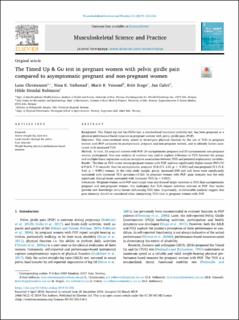| dc.contributor.author | Christensen, Lene | |
| dc.contributor.author | Vøllestad, Nina Køpke | |
| dc.contributor.author | Veierød, Marit Bragelien | |
| dc.contributor.author | Stuge, Britt | |
| dc.contributor.author | Cabri, Jan | |
| dc.contributor.author | Robinson, Hilde Stendal | |
| dc.date.accessioned | 2020-03-16T09:09:22Z | |
| dc.date.available | 2020-03-16T09:09:22Z | |
| dc.date.created | 2019-08-14T23:12:57Z | |
| dc.date.issued | 2019 | |
| dc.identifier.citation | Musculoskeletal Science and Practice. 2019, 43, 110-116. | en_US |
| dc.identifier.issn | 2468-8630 | |
| dc.identifier.uri | https://hdl.handle.net/11250/2646876 | |
| dc.description.abstract | Background: The Timed Up and Go (TUG) test, a standardized functional mobility test, has been proposed as aphysical performance-based measure in pregnant women with pelvic girdle pain (PGP).Objectives:This cross-sectional study aimed to investigate physical function by the use of TUG in pregnantwomen with PGP compared to asymptomatic pregnant and non-pregnant women, and to identify factors asso-ciated with increased TUG.Methods:In total, 25 pregnant women with PGP, 24 asymptomatic pregnant and 25 asymptomatic non-pregnantwomen participated. One-way analysis of variance was used to explore difference in TUG between the groupsand multiple linear regression analyses to explore associations between TUG and potential explanatory variables.Results:The time on TUG varied among pregnant women with PGP, and was significantly higher (mean (95% CI)6.9 (6.5, 7.3) seconds) than for asymptomatic pregnant (5.8 (5.5, 6.0), p < 0.001) and non-pregnant (5.5 (5.4,5.6), p < 0.001) women. In the total study sample, group, increased BMI and sick leave were significantlyassociated with increased TUG (p-values≤0.02). In pregnant women with PGP, pain intensity was the onlysignificant clinical factor associated with increased TUG (p= 0.002).Conclusion:Pregnant women with PGP used longer time and showed larger variation in TUG than asymptomaticpregnant and non-pregnant women, this underpins that TUG targets activities relevant to PGP. Our resultsprovide new knowledge about factors influencing TUG time. Importantly, multivariable analyses suggest thatpain intensity should be considered when interpreting TUG time in pregnant women with PGP. | en_US |
| dc.language.iso | eng | en_US |
| dc.subject | active straight leg raise test | en_US |
| dc.subject | load transfer through the pelvis | en_US |
| dc.subject | pain intensity | en_US |
| dc.subject | weight-bearing physical performance-based measure | en_US |
| dc.title | The Timed Up & Go test in pregnant women with pelvic girdle pain compared to asymptomatic pregnant and non-pregnant women | en_US |
| dc.type | Peer reviewed | en_US |
| dc.type | Journal article | en_US |
| dc.description.version | publishedVersion | en_US |
| dc.rights.holder | © 2019 The Authors. Published by Elsevier Ltd. This is an open access article under the CC BY-NC-ND license (http://creativecommons.org/licenses/BY-NC-ND/4.0/). | en_US |
| dc.source.pagenumber | 110-116 | en_US |
| dc.source.volume | 43 | en_US |
| dc.source.journal | Musculoskeletal Science and Practice | en_US |
| dc.identifier.doi | 10.1016/j.msksp.2019.03.006 | |
| dc.identifier.cristin | 1716044 | |
| dc.description.localcode | Seksjon for fysisk prestasjonsevne / Department of Physical Performance | en_US |
| cristin.unitcode | 150,31,0,0 | |
| cristin.unitname | Seksjon for fysisk prestasjonsevne | |
| cristin.ispublished | true | |
| cristin.fulltext | original | |
| cristin.qualitycode | 1 | |
